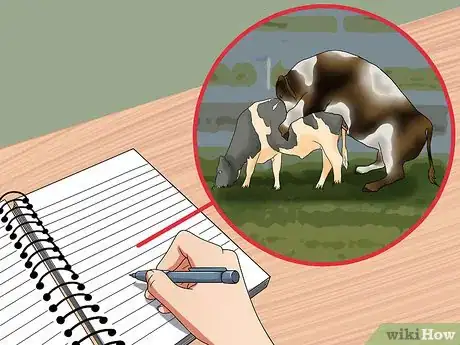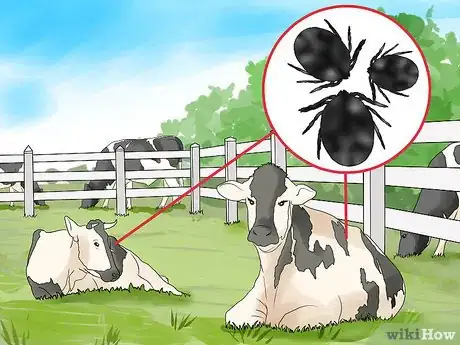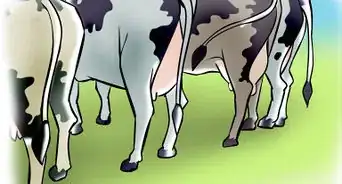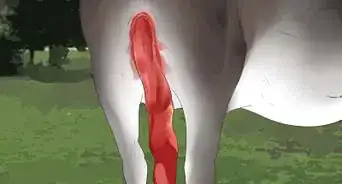This article was co-authored by Karin Lindquist. Karin Lindquist earned a BSc in Agriculture as an Animal Science major from the University of Alberta, Canada. She has over 20 years of experience working with cattle and crops. She's worked for a mixed-practice veterinarian, as a sales representative in a farm supply store, and as a research assistant doing rangeland, soil, and crop research. She currently works as a forage and beef agriculture extension specialist, advising farmers on a variety of issues relating to their cattle and the forages they grow and harvest.
There are 10 references cited in this article, which can be found at the bottom of the page.
wikiHow marks an article as reader-approved once it receives enough positive feedback. This article received 105 testimonials and 92% of readers who voted found it helpful, earning it our reader-approved status.
This article has been viewed 1,307,118 times.
Dairy farms take a lot of money and capital to start up, way more than a meat operation does. Know what you're getting into and how you want to get into it before you decide to start a dairy farm. Even if you grew up on a farm, managing your own means sitting down for long, careful planning sessions. This guide will help you through these, but remember that local knowledge is invaluable for any farmer.
Steps
Planning Your Dairy Farm
-
1Research species and breed. The most common dairy animals are cows, goats (good for a small farm), or water buffalo (in south Asia). Each one has many dairy breeds, and local knowledge is your best way to choose between them. Contact government institutions, university agricultural extensions, and established dairy farms and ask for info to help you make the decision:
- Rule out breeds that can't thrive in your climate.
- For each breed, divide annual upkeep cost by annual milk production to find production cost per unit of milk.
- Is there local demand for the breed's milk (based on species and milk fat %)? What about for butter and cheese (where a high fat % is useful)?
- How much time and money does it take to raise a calf to milk-producing age? How much can you sell the male calves for?
-
2Decide on a food source. Concentrated feed requires less labor but more money. New farms often save on costs by supplementing it with Management Intensive Rotational Grazing (MIRG).[1] Look at land rental prices in your area and determine how many acres of pasture are required for your cattle.
- Livestock need about 4% of their weight in forage each day. Ideally, your pasture should produce more than this at peak season, so you can stockpile the surplus for winter.[2]
- Renting land is usually better than purchasing for a new farm. Wait until your farm is well-established and you no longer need the financial flexibility.
Advertisement -
3Create a breeding plan. Dairy bulls have a reputation for dangerous behavior, and in any case raising one year round gets expensive. The safer options are paying for a bull's service at breeding time, or practicing artificial insemination (AI). AI is almost always the cheapest option, and has equal or higher success rates when performed correctly (ideally by trained AI techs).
- Artificial insemination programs are now widespread in India and many African countries. The savings are not as significant and the programs vary in quality, but it is still usually worth it.
- Male:female herd ratio varies between species and with the male's age. A young bull can typically service 20–25 cows, while a healthy, mature bull may be able to handle up to 40.[3]
-
4Study farming practices. If you don't have dairy farm experience already, take some time to learn about breeding, calving, manure management, weaning, milking cows, and crop management. Farming requires a great deal of time, work, and knowledge, so walk into it with open eyes.
- If this is all new to you, try to get some work experience on another dairy farm first.
-
5Invest in capital. A farm requires a large one-time expenditure to get started. Buying an existing dairy farm makes the task simpler, and can save money if you're willing to do some repairs yourself. Whether you plan to buy or start it all yourself, make sure you'll have the following facilities:[4] [5]
- A sterile facility for storing milk, and for pasteurizing if required in your area
- Dry, sunny sheds or barns protected from weather and temperature changes
- Milking parlor with stanchions
- Feed storage and manure storage
- Separate living space for calves
- Equipment (including tractors) and equipment storage area
- Well for watering cattle, plus water transport system to tanks in pasture
- Irrigation system for pasture (optional)[6]
- Note — if possible, give yourself room to expand to a larger herd
-
6Find a good source for animals. Inspect all dairy animals personally before buying, including several milking tests. The animal should be healthy and vaccinated against disease. Ideally, purchase the animals right after calving, on its second or third lactation (when milk production is highest).[7] Wait to buy the second half the herd until the first group is about to go dry, so your farm can produce milk year round.
-
7Research the local milk market. If you're starting with just a few animals, talk to nearby dairy farmers for advice on selling to local stores and individuals. If you have a slightly larger herd, you can get a more stable income by selling the milk to a company that will handle distribution.
-
8Contact the government. Your local or regional government may require permits and paperwork to run a farm, sell milk, irrigate your land, and/or hire staff to help you.
-
9Create a business plan. Put all your financial estimates into a plan that covers the first few years of your business. In addition to the necessary items above, remember to include the estimated cost of veterinary care per animal, and the cost of any labor you plan to hire. Also look into an additional source of profit: selling manure.
- Contact government institutions about subsidies and loans for farmers before you take out a loan from a bank.
- Use the average milk prices (or slightly lower) over the past few years when estimating future profits. You don't want your business to go under if milk prices drop.
- As a rule of thumb, you'll need one laborer per 10 milk animals, and one per 20 "dry" animals.[8] This includes you and your family.
Learning the Basics
-
1Mark each individual animal. Assuming you have more than a few animals, you'll need to mark them to tell them apart. This will help you track individual milk production and illness. Tagging is a common method.
-
2Control the spread of disease. Always buy disease-free animals, and keep them isolated from other animals during transportation to your farm. Quarantining new arrivals (and animals that fall sick) is recommended, especially if they do not have trustworthy, recent health records. Your local government or veterinarian can give you specific advice about diseases in your area.
-
3Give the animals proper nutrition. Feeding cattle and other livestock can be a complicated business. There are many different kinds of fodder and forage plants, which provide different amounts of energy, protein, roughage, and various nutrients. A veterinarian or experienced farmer can help you work with the food you have available.
- Mineral licks and/or mineral supplements are an important part of the animal's diet.
- Moldy feed or feed stored in the same area as pesticides and other contaminants can transfer dangerous toxins to the milk.[11]
- Dairy animals have high nutrition requirements compared to animals raised for meat. Improper nutrition can lead to lower milk production or lower quality milk.
-
4Milk the animal frequently. Milk-producing animals typically need milking two or three times a day. Move the animal to a clean location. Wash and dry your hands and the udder before milking.
- If you've never milked an animal before, learn how to milk a cow or goat.
-
5Understand the breeding cycle. You will need to breed your female animals regularly to keep them lactating as often as possible. The cycle of breeding, calving, and weaning calves has implications for the animal's nutrition needs, health, and of course milk production. Our guide on cows gives you the basics, but this will vary based on species and age.
- Unlike farms that raise livestock for meat, you will be calving all year round to keep milk production steady. Keeping track of where each animal is in the cycle is vital so you can stick to a plan that keeps your income as regular as possible.
-
6Plan for changes in your herd. Whether to sell, slaughter, or keep an animal is one of the toughest questions for a dairy farmer. Culling allows you to replace a low-yield animal with a higher-quality replacement, and to increase the genetic quality of your herd. Both of these factors are important, but performing them without a plan can add massive costs for replacement animals.[12] Take this into account in your business plan, and include the cost/profit of producing each male and female calf as well.
Community Q&A
-
QuestionCan I start with 8-10 animals?
 Community AnswerYes. There is no bar for the quantity.
Community AnswerYes. There is no bar for the quantity. -
QuestionIs it possible to start with a single cow?
 Community AnswerYes, but it's not profitable. It's better to start with at least 5-6 cows.
Community AnswerYes, but it's not profitable. It's better to start with at least 5-6 cows. -
QuestionIs a dairy business profitable?
 Community AnswerIt may be profitable if you make the right business decisions.
Community AnswerIt may be profitable if you make the right business decisions.
Warnings
- Don't go in to this operation thinking it's going to be a smooth ride. You will be very busy from before sunrise to past sunset every day, doing everything from milking cows to red tape to fixing machinery. It helps to have trusty hired hands, but you will need to supervise them to keep the farm running smoothly.⧼thumbs_response⧽
- Starting a dairy farm is very expensive. Going too far into debt can be very risky without a second job to rely on, since a shift in grain or milk prices could bankrupt you. If you don't have the finances yet, consider raising animals for meat instead.⧼thumbs_response⧽
References
- ↑ http://www.cias.wisc.edu/starting-your-own-dairy-farm/
- ↑ http://www.nrcs.usda.gov/Internet/FSE_DOCUMENTS/stelprdb1097070.pdf
- ↑ http://extension.uga.edu/publications/detail.cfm?number=C553
- ↑ http://www.vethelplineindia.co.in/starting-a-dairy-farm-india/
- ↑ http://www.yourarticlelibrary.com/dairy-farm-management/dairy-cattle-housing-and-layout-of-dairy-farm/36250/
- ↑ http://onpasture.com/2014/06/16/should-i-irrigate-my-pastures/
- ↑ http://www.sites.ext.vt.edu/newsletter-archive/dairy/2004-02/lactation.html
- ↑ http://www.vethelplineindia.co.in/starting-a-dairy-farm-india/
- ↑ http://www.vethelplineindia.co.in/wp-content/uploads/2012/12/GoodDairyFarmingPractice_FAO.pdf
About This Article
If you want to start a dairy farm, decide which species and breed you'd like to keep, such as cows, goats, or water buffalo. Then, choose a food source, such as feed, hay, or grazing, and with the cost of labor and land in mind. Once you've decided on these, make a breeding plan, which might involve paying for a bull's service or doing artificial insemination. Make sure you know about the care requirements for dairy animals of all ages, since you will have both adult and baby animals. When you're ready to start the farm, make sure you have all permits in order and make a business plan to propose to investors. For tips on learning the basics of dairy farming and taking care of dairy animals, read on!














































































